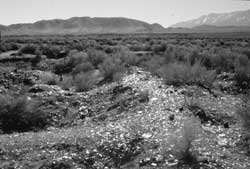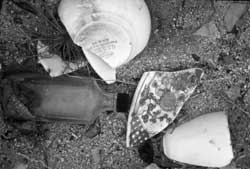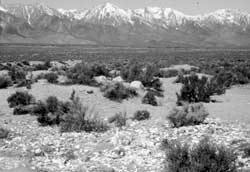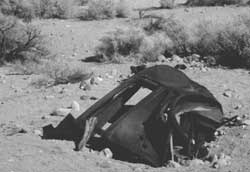MENU
|
| |
Confinement and Ethnicity: An Overview of World War II Japanese American Relocation Sites by J. Burton, M. Farrell, F. Lord, and R. Lord |

|
|
| |
Chapter 8 (continued)
Manzanar Relocation Center
Outlying Area
Landfill and Disposal Pits
The relocation center landfill covers 18 acres north of Bairs Creek about 1,000 feet west of the fenced central portion of the relocation center. The landfill consists of scattered trash and buried trash-filled trenches. There appears to have been at least five trenches, up to 400 feet long and 6 feet deep. Thousands of artifacts have been exposed by relic collectors at the two easternmost trenches (Figure 8.110). These include Japanese and government-issued ceramic fragments and dozens of intact bottles (mostly clear, with a wide variety of different shapes and sizes), some with readable paper labels (Figure 8.111). Also present in lesser amounts are sanitary seal cans, trash can lids, barbed wire, automobile parts, cast iron fragments, screws, wire nails, and oil drums. A separate deposit, cut by a recent gully, contains roofing materials, drywall, and thousands of fragments of government-issued plates, dishes, platters, and cups. The landfill was capped by the National Park Service in 1998 to deter digging by collectors.
 Figure 8.110. Manzanar Relocation Center landfill in 1994. |
 Figure 8.111. Typical artifacts at the Manzanar Relocation Center landfill. |
A 2-1/2-acre-area west of the relocation center cemetery was used for trash disposal when the relocation center closed. One area was used exclusively for the disposal of government-issued hotel ware ceramics (Figure 8.112), other areas were used for the disposal of large debris, such as vehicles, vehicle parts, concrete, and other items. Portions of at least ten partially buried vehicles are visible (Figure 8.113).
 Figure 8.112. Ceramic disposal pit at the Manzanar Relocation Center. |
 Figure 8.113. Partially-buried evacuee automobile west of the Manzanar cemetery. |
 Top
Top
Last Modified: Fri, Sep 1 2000 07:08:48 pm PDT
http://www.cr.nps.gov/history/online_books/anthropology74/ce8p.htm
![]()

